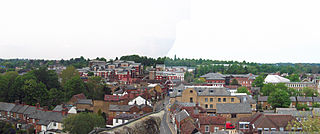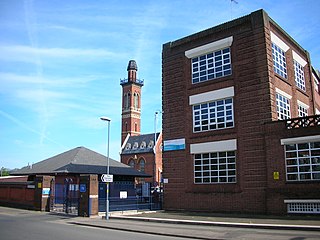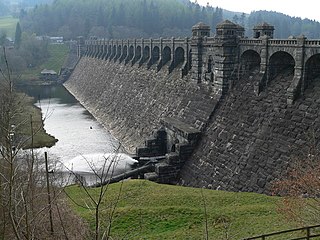
Watford is a town and non-metropolitan district with borough status in Hertfordshire, England, 15 miles (24 km) northwest of Central London, on the banks of the River Colne.

Rickmansworth is a town in south-west Hertfordshire, England, located approximately 17 miles (27 km) north-west of central London, 5 miles (8 km) south-west of Watford and inside the perimeter of the M25 motorway. The town is mainly to the north of the Grand Union Canal and the River Colne.

Thirlmere is a reservoir in the Borough of Allerdale in Cumbria and the English Lake District. The Helvellyn ridge lies to the east of Thirlmere. To the west of Thirlmere are a number of fells; for instance, Armboth Fell and Raven Crag both of which give views of the lake and of Helvellyn beyond.

The Colne is a river and a tributary of the River Thames in England. Just over half its course is in south Hertfordshire. Downstream, it forms the boundary between Buckinghamshire and the London Borough of Hillingdon. The confluence with the River Thames is on the Staines reach at Staines-upon-Thames.

The Metropolitan Water Board was a municipal body formed in 1903 to manage the water supply in London, UK. The members of the board were nominated by the local authorities within its area of supply. In 1904 it took over the water supply functions from the eight private water companies which had previously supplied water to residents of London. The board oversaw a significant expansion of London's water supply infrastructure, building several new reservoirs and water treatment works.

Bristol Water is a British water company which supplies 266 million litres of drinking water daily to over 1.2 million customers in a 2,600 km2 (1,000 sq mi) area centred on Bristol, England. It is regulated under the Water Industry Act 1991. Sewerage services in the Bristol area are provided by Wessex Water.

The Watford and Rickmansworth Railway (W&RR) ran services between Watford and Rickmansworth in Hertfordshire, England. The company was incorporated in 1860; the line opened in 1862. The Rickmansworth branch was closed in 1952, and the remaining line was gradually run down and eventually closed in 1996.
The Watford and Edgware Railway (W&ER) was a company established in the 1860s in the United Kingdom to build a railway between Edgware in North London and Watford, Hertfordshire, via Bushey. Its planned 6.25-mile (10.06 km) route would have extended the railway line which forms part of the present-day Northern line on the London Underground network. Nothing substantial was constructed.

The Colne Valley Waterworks railway was a 2 ft narrow gauge industrial railway connecting the London, Midland and Scottish Railway (LMS) Watford to Rickmansworth branch line with the Eastbury Pumping Station to deliver coal.

The William Girling Reservoir is located in the London Borough of Enfield and is part of the Lee Valley Reservoir Chain that supplies London with drinking water. It is named after William Girling OBE, a chairman of the Metropolitan Water Board (MWB). The reservoir and the nearby King George V Reservoir are known collectively as the Chingford Reservoirs. The storage reservoir, which is owned by Thames Water, is bordered by Chingford to the east and Ponders End and Edmonton to the west, and covers 334 acres with a perimeter of 3.5 miles (5.6 km). There is no public access.

Veolia Water Central was a privately owned company supplying water to Hertfordshire and parts of Surrey, North London and Bedfordshire, in England. It was owned by Veolia Environnement, a French company with international interests in the water, waste management, energy and transportation sectors.

The Staines Reservoirs are two large pumped storage reservoirs sitting to the east of the King George VI Reservoir near Heathrow airport in Surrey within the Colne Valley regional park. The village of Stanwell is mainly to the north east, and the town of Staines is to the south.

London's water supply infrastructure has developed over the centuries in line with the expansion of London.

Ardleigh Reservoir is a 49-hectare (120-acre) lake near Colchester in Essex, England constructed in the valley of the Salary Brook. It supplies water both to Anglian Water and to Affinity Water. The lake is also used for recreational activities including sailing and angling.

The Colne Valley Regional Park is 43 square miles (110 km2) of parks, green spaces and reservoirs alongside the often multi-channel River Colne and parallel Grand Union Canal, mainly in Hertfordshire and Buckinghamshire, with parts in the London Borough of Hillingdon, Berkshire and a small area in Surrey.

The Birmingham Corporation Water Department was responsible for the supply of water to Birmingham, England, from 1876 to 1974. It was also known as Birmingham Corporation Waterworks Department.

The City of Nottingham Water Department (1912–1974), formerly the Nottingham Corporation Water Department (1880–1912), was responsible for the supply of water to Nottingham from 1880 to 1974. The first water supply company in the town was the Nottingham Waterworks Company, established in 1696, which took water from the River Leen, and later from springs at Scotholme, when the river became polluted. Other companies were set up in the late 18th century and in 1824, while in 1826 the Trent Water Company was established. They employed Thomas Hawksley as their engineer, who became one of the great water engineers of the period, and Nottingham had the first constant pressurised water supply system in the country. The various companies amalgamated in 1845, and Hawksley remained as the consulting engineer until 1879.
Essex and Suffolk Water is a water supply company in the United Kingdom. It operates in two geographically distinct areas, one serving parts of Norfolk and Suffolk, and the other serving parts of Essex and Greater London. The total population served is 1.8 million. Essex and Suffolk is a 'water only' supplier, with sewerage services provided by Anglian Water and Thames Water within its areas of supply. It is part of the Northumbrian Water Group.

Liverpool Corporation Waterworks and its successors have provided a public water supply and sewerage and sewage treatment services to the city of Liverpool, England. In 1625 water was obtained from a single well and delivered by cart, but as the town grew, companies supplied water to homes through pipes. There were two main companies by the 1840s, but the water supply was intermittent, and there was general dissatisfaction with the service. Liverpool Corporation decided that such an important service should be provided by a public body, and sought to take over the water supply companies.

Lincoln Corporation Waterworks and its predecessors and successors have provided a public water supply and sewerage and sewage treatment services to the city of Lincoln, England. The Romans are known to have built a conduit from the Roaring Meg stream to a water tower in East Bight. Further development took place in 1846, when the Lincoln Water Company was established, following a national outbreak of cholera in 1831-32. The main source of supply was formed by impounding Prial Drain to form Hartsholme Lake. The water was filtered by sand filters at Boultham, and was pumped to a service reservoir at Westgate. Lincoln Corporation wanted to gain control of their water supply, and bought out the water company in 1871. The enabling act of Parliament also allowed them to construct a sewerage network, which fed a sewage farm at Canwick, but the Bracebridge area was not connected to the sewers, and waste water polluted local watercourses. There were sporadic outbreaks of typhoid and cholera, although the Corporation argued that these might not be linked to a polluted water supply.


















